
a.
To find: The time when rocket stopped climbing.
a.
Answer to Problem 18E
The velocity of the rocket is
Explanation of Solution
Given information:
The velocity time graph is as shown below.
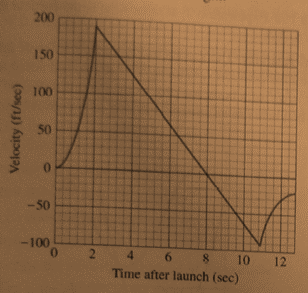
Calculation:
From the velocity time graph the
At
So, the velocity at that time is
Conclusion: So, the velocity of the rocket when the engine stopped is
b.
To find: The time duration of the burning of the engine.
b.
Answer to Problem 18E
The time duration is
Explanation of Solution
Given information:
The velocity time graph is as shown below.
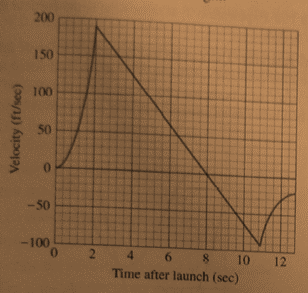
Calculation:
From the given graph the
The time duration of the engine burning is
Conclusion: So, the engine burned for
c.
To find: The time and velocity when the rocket reached its highest point.
c.
Answer to Problem 18E
The time is
Explanation of Solution
Concept used:
The highest point is reached when the velocity is zero.
Given information:
The velocity time graph is shown below.
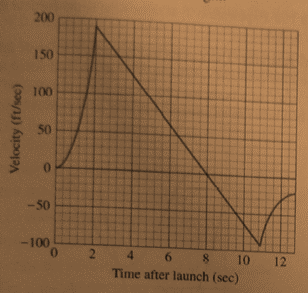
Calculation:
From the graph the highest point is reached when velocity is
From the graph the time when the rocket reached its highest point is
Conclusion: So, time is
d.
To find: The time and velocity when the parachute pop out.
d.
Answer to Problem 18E
The time is
Explanation of Solution
Concept used:
The highest point is reached when the velocity is zero.
Given information:
The velocity time graph is shown below.
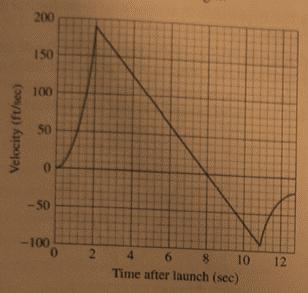
Calculation:
From the graph the parachute pops out is when velocity is
From the graph the time when the parachute pops out is
Conclusion: So, time is
e.
To find: The time of the rocket fall when parachute opened.
e.
Answer to Problem 18E
The time of fall is
Explanation of Solution
Concept used:
The highest point is reached when the velocity is zero.
Given information:
The velocity time graph is shown below.
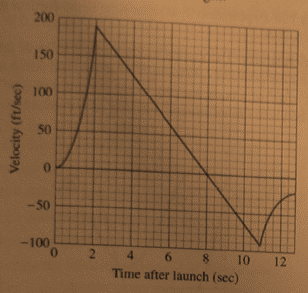
Calculation:
From the graph the velocity is
From the graph the time when the parachute pop out is
So, fall will be equal to
Conclusion: So, time is
f.
To find: The time when acceleration is greatest and when the acceleration is constant.
f.
Answer to Problem 18E
The time when acceleration is greatest when
Explanation of Solution
Given information:
The velocity time graph is shown below.
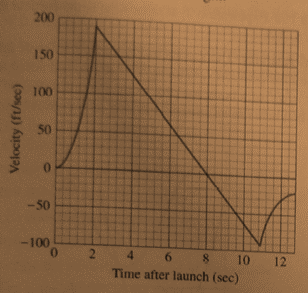
Calculation:
From the graph the time of greatest acceleration is
From the graph the time of constant acceleration is at
Conclusion: So, time when acceleration is greatest is
Chapter 2 Solutions
AP CALCULUS TEST PREP-WORKBOOK
- Let a = (-4, 5, 4) and 6 = (1,0, -1). Find the angle between the vector 1) The exact angle is cos 2) The approximation in radians isarrow_forwardFind the (exact) direction cosines and (rounded to 1 decimal place) direction angles of = (3,7,6)arrow_forwardLet a = (-1, -2, -3) and 6 = (-4, 0, 1). Find the component of b onto a.arrow_forward
- Forces of 9 pounds and 15 pounds act on each other with an angle of 72°. The magnitude of the resultant force The resultant force has an angle of pounds. * with the 9 pound force. The resultant force has an angle of with the 15 pound force. It is best to calculate each angle separately and check by seeing if they add to 72°.arrow_forward= Let (6,2,-5) and = (5,4, -6). Compute the following: บี.บี. บี. นี = 2 −4(u. v) = (-4). v= ū. (-40) (ū. v) v =arrow_forwardLet ā-6+4j- 1k and b = 7i8j+3k. Find a. b.arrow_forward
- Find the volume of the parallelepiped determined by the vectors a = (3, 5, −1), ☎ = (0, 3, 1), c = (2,4,1).arrow_forwardFind the area of a triangle PQR, where P = (-5,6, -1), Q = (1, -3, -2), and R = (-5, -1,4)arrow_forward17. [-/1 Points] DETAILS MY NOTES SESSCALCET2 6.2.050. Evaluate the integral. (Remember to use absolute values where appropriate. Use C for the constant of integration.) du 4√3- -4² Need Help? Read It SUBMIT ANSWER 18. [-/1 Points] DETAILS MY NOTES SESSCALCET2 6.2.051. Evaluate the integral. (Use C for the constant of integration.) - 49 dx x² +3 Need Help? Read It Watch It SUBMIT ANSWER 19. [-/1 Points] DETAILS MY NOTES SESSCALCET2 6.2.057. Evaluate the integral. (Remember to use absolute values where appropriate. Use C for the constant of integration.) 25+ x2 dxarrow_forward
- Let (5,3,-7) and = (2, -3, -6). = Compute the following: u× u = -4(u xv) ux (-4v) (+v) × v=arrow_forwardLet a = (4, -2, -7) and 6 = (2,5, 3). (ã − ò) × (ã + b) =arrow_forwardUse the graph of the function y = f (x) to find the value, if possible. f(x) 8 7 6 Q5 y 3 2 1 x -8 -7 -6 -5 -4 -3 -2 -1 1 2 3 4 5 6 7 8 -1 -2 -3 -4 -5 -6 -7 -8+ Olim f(z) x-1+ O Limit does not exist.arrow_forward
 Calculus: Early TranscendentalsCalculusISBN:9781285741550Author:James StewartPublisher:Cengage Learning
Calculus: Early TranscendentalsCalculusISBN:9781285741550Author:James StewartPublisher:Cengage Learning Thomas' Calculus (14th Edition)CalculusISBN:9780134438986Author:Joel R. Hass, Christopher E. Heil, Maurice D. WeirPublisher:PEARSON
Thomas' Calculus (14th Edition)CalculusISBN:9780134438986Author:Joel R. Hass, Christopher E. Heil, Maurice D. WeirPublisher:PEARSON Calculus: Early Transcendentals (3rd Edition)CalculusISBN:9780134763644Author:William L. Briggs, Lyle Cochran, Bernard Gillett, Eric SchulzPublisher:PEARSON
Calculus: Early Transcendentals (3rd Edition)CalculusISBN:9780134763644Author:William L. Briggs, Lyle Cochran, Bernard Gillett, Eric SchulzPublisher:PEARSON Calculus: Early TranscendentalsCalculusISBN:9781319050740Author:Jon Rogawski, Colin Adams, Robert FranzosaPublisher:W. H. Freeman
Calculus: Early TranscendentalsCalculusISBN:9781319050740Author:Jon Rogawski, Colin Adams, Robert FranzosaPublisher:W. H. Freeman
 Calculus: Early Transcendental FunctionsCalculusISBN:9781337552516Author:Ron Larson, Bruce H. EdwardsPublisher:Cengage Learning
Calculus: Early Transcendental FunctionsCalculusISBN:9781337552516Author:Ron Larson, Bruce H. EdwardsPublisher:Cengage Learning





